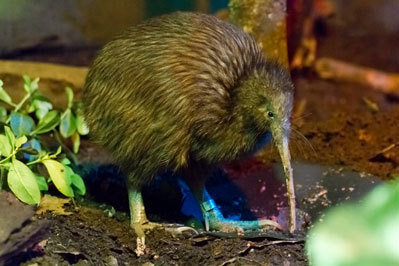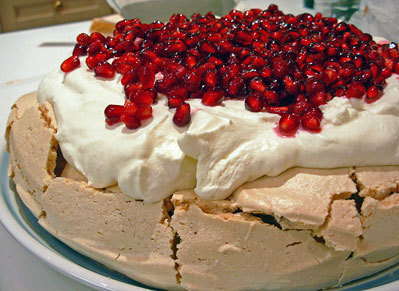





Did you know that Kiwi is a relatively new name for this nutrient-dense fruit? Join me on my quest to learn about the history, nutrition and varieties of Kiwi, as well as how-to-grow this delicious treat. Enjoy Kiwi as a healthy snack and as a serving of fresh fruit. It has a pleasant, fruity flavor, appealing color and high Vitamin C content, adding nutrition, eye appeal and flavor to holiday fruit trays, fruit tarts and pavlova. Try Kiwi pureed in fruit dips, smoothies, and frozen sorbets, or as a natural tenderizer for meats.
 History of Kiwi
History of Kiwi
Kiwi (Actinidia deliciosa), native to southern China and the national fruit of the People's Republic of China, has a history with somewhat of an identity crisis as Prunes. Sagging sales of prunes led to them being renamed to dried plums. Like dried plums, Kiwi started out with other names too. Kiwi was called Yang tao and Chinese gooseberry. In efforts to revive sales of Kiwi in the international market in the 1950s, U.S. Kiwi importer, Ziel & Co located in San Francisco, recommended a shorter - catchier - name: Melonette. Cute name with a nice ring to it, but Kiwi flesh did not have the taste and texture of melon. The fruit was again renamed, this time to Kiwifruit by Turners & Growers, in 1962. The name was unique and a good fit. Kiwifruit remains the name as we know it today.
According to the California Kiwifruit Commission, California began producing Kiwifruit in the late 1960s. Popularity skyrocketed in the 1980s, and Kiwi ranked in 1992 as one of the top 10 nutritious foods. Kiwifruits are also imported to the United States, with most coming from Italy, New Zealand and Chile, making Kiwi available year-round.
 Kiwifruit
Kiwifruit
Kiwi was an appropriate name for fruit coming primarily from New Zealand. The name Kiwi represented the New Zealand people and was named after a brown Kiwi bird (Apteryx mantelli) that is New Zealand's national symbol, used on their currency and postage stamps. Brown Kiwi birds don't fly. They are shy, noctu rnal creatures, the size of chickens, and have been battling extinction because of predators that include feral cats, ferrets and stoats (short-tailed weasels).
rnal creatures, the size of chickens, and have been battling extinction because of predators that include feral cats, ferrets and stoats (short-tailed weasels).
Sliced kiwifruit or pomegranate seeds have long been used as a garnish atop Chantilly whipped cream on New Zealand's national meringue-based dessert called pavlova - named after Russian ballet dancer Anna Pavlova.
 Growing Kiwi
Growing Kiwi
Personally, I've never grown Kiwi. A neighbor of ours grew Kiwi on a trellis in zone 6b for the vine and leaves, not for the fruits. Needing a long growing season to ripen and mature, Kiwifruits are still hard and sour in September and October. Kiwi harvest isn't usually until late season November and December, which is why Kiwi grows best in places like New Zealand and in Mediterranean areas or regions that allow for a longer growing season. Canes are pruned after harvest, and the vines lay dormant during the winter.
Growing Kiwi reminds me of growing grapes, with a few exceptions: the long growing season and, excluding a few self-pollinating cultivars, that the majority of kiwi are dioecious - meaning that fruiting requires both male and female plants. Only insect pollinated blooms will produce nutritious Kiwifruits. 
As with grape vines, Kiwi vines require plenty of sunshine. Kiwifruits grow best in fertile soil having pH levels between 5 and 6.8. And like grapes, new shoots begin to emerge in the spring and growth is vigorous during the summer.
 Kiwi Varieties
Kiwi Varieties
Most Kiwi fruits we see in markets are either Actinidia deliciosa 'Hayward', 'Chico' or 'Saanichton 12', which are green and taste similar. Exotic varieties include ENZAGoldTM and Zespri® Gold Kiwifruit (Actinidia chinensis), both of which feature smooth, fuzz-free skin with unusual yellow colored flesh.
More recent and innovative Kiwi cultivars include the Fall 2010 release of ENZARedTM by Turners & Growers at Hong Kong's Asia FRUIT LOGISTICA. This Chinese Hongyang cultivar features an appealing red starburst center on gold flesh. The world's first commercially grown red Kiwi is produced in China and exported internationally with sales in Asia and Italy. The fruit developer is now propagating and grafting red Kiwi plants in New Zealand for growers.
Kiwi Berries (Actinidia arguta), also known as Bower actinidia, grape Kiwi, arctic Kiwi, cocktail Kiwi, dessert Kiwi or hardy Kiwifruit, is another new cultivar to enter the produce market with limited availability. The smaller sized Kiwi has a short season. Look for the hand picked mini kiwis in specialty markets in late fall through early March. Introduced in 1992, the cold-tolerant, miniature baby Kiwi made their debut on Hurst's Berry Farm in Sheridan, Oregon. They are also grown in Chile.
Snack-sized Kiwi berries grow the size of grapes and are eaten like grapes with the skin on. Skins are smooth, rather than fuzzy. The perennial vines can grow up to 100 feet! Actinidia arguta ‘Issai', is a more manageable, self-pollinating dwarf "Mini Kiwi" variety, growing only to 12 feet or so, and can grow in part shade, hardy to USDA zones 5*-10. *Zone 5 may not provide a long enough season to produce ripe fruits.
 Kiwi Nutrition
Kiwi Nutrition
Like many fruits and vegetables, Kiwi is a natural source of carotenoids: lutein and zeaxanthin - plant pigments that provide antioxidant protection against disease. Kiwifruits contain dietary fiber and many vitamins and minerals. The edible portion of one Kiwi provides greater than 100% of the Daily Value of Vitamin C, making it a high source. Kiwi seeds, visible in the center of the fruit when cut, are edible and so is the skin. However, the fuzzy texture on regular size kiwifruit may be unappealing and the skin is often peeled before eating. For a quick snack, Kiwi can be cut in half and the pulp eaten with a spoon.
Kiwifruit is also rich in actinidin, a cysteine protease (protein-dissolving) enzyme that is in the same family of thiol proteases like papain, found in papaya and mangos. Actinidin is commercially used in meat tenderizer Kiwi-based products.
Kiwi Nutrition Data*: One 2" green Kiwifruit provides: 10g carbohydrates, .8g protein, 2g (8%DV) dietary Fiber, 215mg (6%DV) Potassium, 64mg (107%DV) Vitamin C (an excellent source!), 17 mcg (4%DV) Folate, 84mcg Lutein + Zeaxanthin, 1mg (3%DV) Vitamin E and other healthy nutrients.
Percent Daily Values (%DV) are for adults or children age 4 or older and are based on a 2,000 calorie reference diet. Your daily values may be higher or lower based on your individual needs.
 Kiwi Allergies
Kiwi Allergies
During my food service rotation as a dietetic intern at South Jersey Healthcare's Regional Medical Center, one of the food allergies food service staff had to watch out for was Kiwi. People allergic to latex, pineapple or papaya could also be allergic to Kiwi's protein-dissolving enzyme, actinidin. If you think you may be susceptible, be sure to check with your doctor before eating or growing Kiwi. Common symptoms include itching of the mouth, lips and palate.
Related Links: California Kiwifruit Commission
Baby Kiwi Albion Cooks blog
Kiwi bird versus Stoat: National symbol of New Zealand endangered by voracious species
Baby Kiwi Specialty Produce
Baby Kiwi Melissa's
Editor's note: This article was originally published on January 6th, 2012
Copyright © www.100flowers.win Botanic Garden All Rights Reserved